
Liepouris Savatiano
The history of vineyards and wine production in Attica traces its roots back in antiquity. According to Greek mythology, God Dionysus visited Attica and entrusted its inhabitants with the secrets of the cultivation of the vine.
Nowadays, the inhabitants of Mesogeia, an agricultural area only a few kilometres southeast of downtown Athens, the nation’s capital, carry on the thousands of years old traditional viticulture while adjusting it to modern methods and consumer needs.
It’s all about location
Besides the fact that arable land in Mesogeia stretches out at approximately 65,000 acres, the geographical location of the area, situated at the foot of Mount Paneo and at close proximity to the surrounding coast, make it one of the most favorable areas for vineyards.
The two most crucial factors for the survival of a delicate cultivation such as vineyards are the quality of the soil and the microclimate of the area. In particular, the mild features of the seasons combined with seawater vapour form an excellent environment for grape growing and sustainable vineyards. On both accounts, Attica and in particular Mesogeia region score very high.
Three generations of winemaking
 One of the oldest wineries in the region belongs to Liepouris family. With a rich history of fine wine production dating back to 1952, this family knows a thing or two about the world renowned nectar that comes from fermenting grapes. As they would better explain, the secret to success is merging respect for the principles and secrets of tradition and implementation of modern vinification methods, resulting in tasty wines of exceptional quality.
One of the oldest wineries in the region belongs to Liepouris family. With a rich history of fine wine production dating back to 1952, this family knows a thing or two about the world renowned nectar that comes from fermenting grapes. As they would better explain, the secret to success is merging respect for the principles and secrets of tradition and implementation of modern vinification methods, resulting in tasty wines of exceptional quality.
The family-owned vineyards stretch out to cover an area of 180 acres, where the dominant variety is the indigenous to Mesogeia Savvatiano grape.




